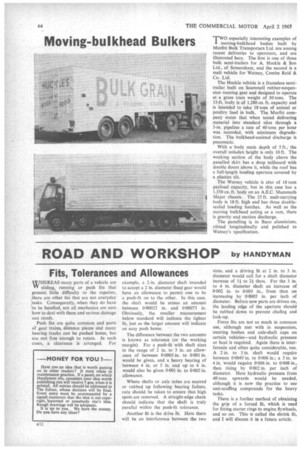ROAD AND WORKSHOP by HANDYMAN
Page 66

If you've noticed an error in this article please click here to report it so we can fix it.
Fits, Tolerances and Allowances
WHEREAS many parts of a vehicle are VV sliding, running or push fits that present little difficulty to the repairer, 'there are other fitsthat are not everyday .tasks, Consequently, when they do have to be handled, not all mechanics are sure how to deal with them and serious damage can result.
Push fits are quite common and parts of gear trains, distance pieces and many bearing tracks can be pushed home, but are not free enough to rotate. In such cases, a clearance is arranged. For example, a 2-in, diameter shaft intended to accept a 2 in, diameter fixed gear would have an allowance to permit one to be a push-fit on to the other. In this case, the shaft would be minus an amount between 0-00025 in. and 0-00075 in. Obviously, the smaller measurement below standard will indicate the tighter fit, just as the larger amount will indicate an easy push home.
The difference between the two amounts is known as tolerance (or the working margin). For a push-fit with shaft sizes in the range of 2 in. to 3 in. an allowance of between 0.0005 in. to 0-001 in. would be given, and a heavy bearing of between 4 in. or $ in. and up to 6 in. would also be given 0.001 in. to 0.002 in. allowance.
Where shafts or axle tubes are scarred or rubbed up following bearing failure, care should be taken to ensure that high spots are removed. A straight-edge check should indicate that the shaft is truly parallel within the push-fit tolerance.
Another fit is the drive -fit. Here there will be an interference between the two sizes, and a driving fit at 2 in. to 3 in. diameter would call for a shaft diameter increase of 1+ to 2+ thou. For the 3 in. to 4 in. diameter shaft an increase of 0.002 in. to 0.003 in., from then on increasing by 0.0005 in. per inch of diameter. Before new parts are driven on, the leading edge of the aperture should be rubbed down to prevent chafing and lock-up.
Force fits are not so much in common use, although met with in suspension, steering bushes and axle-shaft caps on certain vehicles—and hydraulic pressure or heat is required. Again there is interferene and often quite considerable, too. A 2 in. to 3 in. shaft would require between 0.0045 in. to 0.006 in.; a 3 in. to 4 in. would require 0-006 in. to 0.008 in., then rising by 0.002 in. per inch of diameter. Here hydraulic pressure from 40 tons upwards would be needed, although it is now the practice to use anti-scuffing compounds for the heavy tasks.
There is a further method of obtaining the grip of a forced fit, which is used for fitting starter rings to engine flywheels, and so on. This is called the shrink fit, and I will discuss it in a future article.


































































































































































